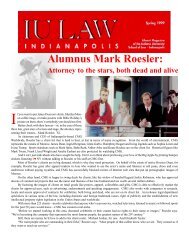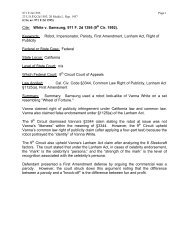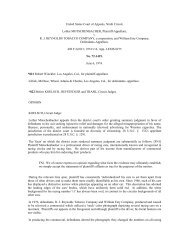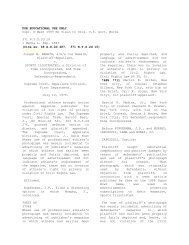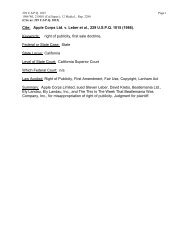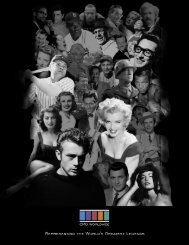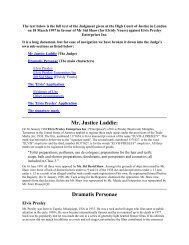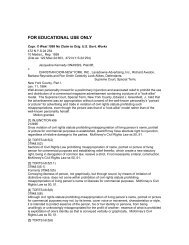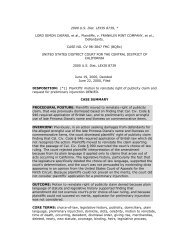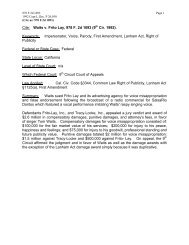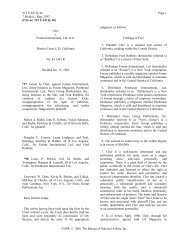Abdul Jabbar v. General Motors - Mark Roesler
Abdul Jabbar v. General Motors - Mark Roesler
Abdul Jabbar v. General Motors - Mark Roesler
- No tags were found...
Create successful ePaper yourself
Turn your PDF publications into a flip-book with our unique Google optimized e-Paper software.
75 F.3d 1391 Page 664 USLW 2507, 37 U.S.P.Q.2d 1694, 96 Cal. Daily Op. Serv. 906, 96 Daily Journal D.A.R. 1445(Cite as: 75 F.3d 1391)the three New Kids requirements as a matter of law.We conclude, however, that there was a genuineissue of fact as to the third requirement, impliedendorsement or sponsorship. Like the newspapersin New Kids, <strong>General</strong> <strong>Motors</strong> could not refer toplaintiff without using his name, and it used nomore th an was necessary to refer to him.Also, analogously to the newspapers in New Kidsasking their readers which New Kid was the best,sexiest, etc., the defendant was selling something,newspapers or cars, different from the product theplaintiff was selling, and their products could notbe confused.[11] The distinction between this case and NewKids is that use of celebrity endorsements intelevision commercials is so well established bycommercial custom that a jury might find animplied endorsement in <strong>General</strong> <strong>Motors</strong>' use of thecelebrity's name in a commercial, which would notinhere in a newspaper poll. Newspapers andmagazines commonly use celebrities' names andphotographs without making endorsementcontracts, so the public does not infer anendorsement agreement from the use. Manypeople may assume that when a celebrity's name isused in a television commercial, the celebrityendorses the product advertised. Likelihood ofconfusion as to endorsement is therefore a questionfor the jury. White v. Samsung Elec. Am., Inc., 971F.2d 1395, 1400-01 (9th Cir.1992) (holding thatuse of a robot dressed and posed like Vanna Whitenext to a "Wheel of Fortune" set raised sufficientquestion of fact as to endorsement under theLanham Act to preclude summary judgment), cert.denied, 508 U.S. 951, 113 S.Ct. 2443, 124 L.Ed.2d660 (1993).By using Alcindor's record to make a claim for itscar--like the basketball star, the Olds 88 won an"award" three years in a row, and like the star, thecar is a "champ" and a "first round pick"--GMChas arguably attempted to "appropriate the cachetof one product for a different one," if not also to"capitalize on consumer confusion." New Kids at308. We therefore hold that there is a question offact as to whether GMC is entitled to a fair usedefense.c) <strong>Abdul</strong>-<strong>Jabbar</strong>'s Lanham Act claim[12] In considering celebrities' claims of violationunder the Lanham Act, we have considered thefollowing factors to determine whether a plaintiffhas raised a genuine issue of material fact as tolikelihood of confusion over endorsement: "(1)strength of the plaintiff's mark; (2) relatedness ofthe goods; (3) similarity of the marks; (4)evidence of actual confusion; (5) marketingchannels used; (6) likely degree of purchaser care;(7) defendant's intent in selecting the mark."White, 971 F.2d at 1400.*1398 The parties dispute the applicability of thefactors. GMC concedes that the fifth factor,marketing channels, favors <strong>Abdul</strong>-<strong>Jabbar</strong>, butcontests the rest. Because a jury could reasonablyconclude that most of the factors weigh inplaintiff's favor, we hold that the question ofwhether <strong>Abdul</strong>- <strong>Jabbar</strong>'s Lanham Act claim shouldsucceed is a question for the jury.IIState law claims: Common Law and StatutoryRights of Privacy[13] "California has long recognized a common lawright of privacy ... [which includes protectionagainst] appropriation, for the defendant's advantage,of the plaintiff's name or likeness." Eastwood v.Superior Court for Los Angeles County, 149Cal.App.3d 409, 198 Cal.Rptr. 342, 346 (1983)(citations omitted). The right to be protected againstsuch appropriations is also referred to as the "right ofpublicity." Id., 198 Cal.Rptr. at 347.The so-called right of publicity means in essencethat the reaction of the public to name and likeness,which may be fortuitous or which may be managedand planned, endows the name and likeness of theperson involved with commercially exploitableopportunities. The protection of name andlikeness from unwarranted intrusion or exploitationis the heart of the law of privacy.Lugosi v. Universal Pictures, 25 Cal.3d 813, 160Cal.Rptr. 323, 329, 603 P.2d 425, 431 (1979).[14] As set out in Eastwood, a common law causeof action for appropriation of name or likeness maybe pleaded by alleging "(1) the defendant's use ofplaintiff's identity; (2) the appropriation ofplaintiff's name or likeness to defendant'sadvantage, commercially or otherwise; (3) lack ofconsent; and (4) resulting injury." 198 Cal.Rptr. at347.[15] We recently clarified in White that "the 'nameor likeness' formulation referred to in Eastwoodoriginated not as an element of the right ofpublicity cause of action, but as a description of the



